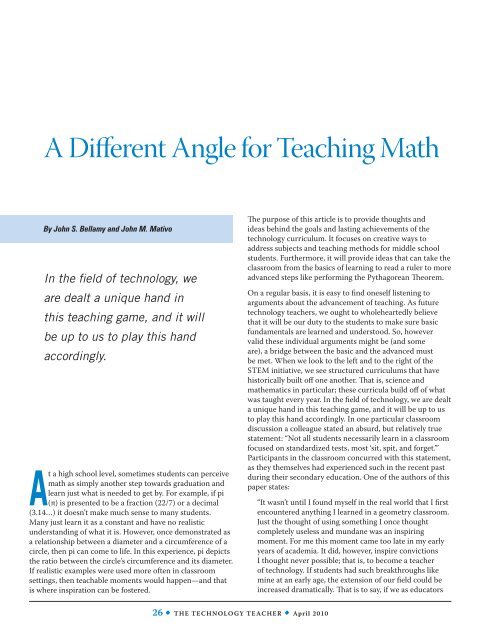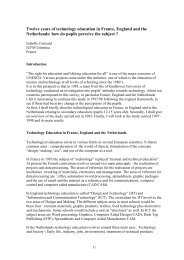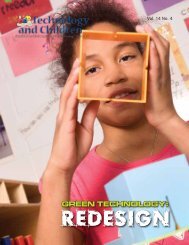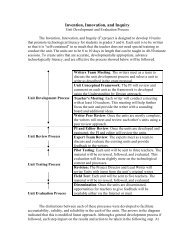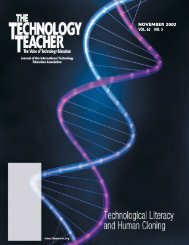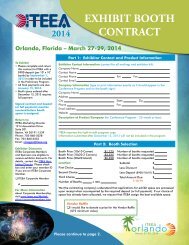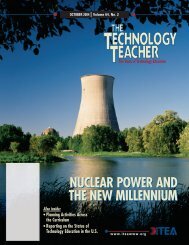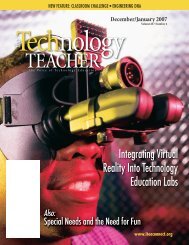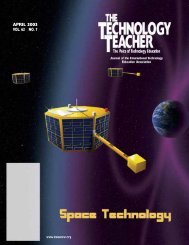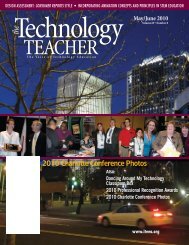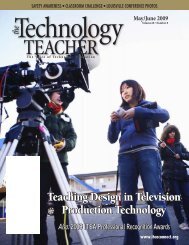Medical Technology: organ harvesting and Transplants
Medical Technology: organ harvesting and Transplants
Medical Technology: organ harvesting and Transplants
Create successful ePaper yourself
Turn your PDF publications into a flip-book with our unique Google optimized e-Paper software.
A Different Angle for Teaching Math<br />
By John S. Bellamy <strong>and</strong> John M. Mativo<br />
In the field of technology, we<br />
are dealt a unique h<strong>and</strong> in<br />
this teaching game, <strong>and</strong> it will<br />
be up to us to play this h<strong>and</strong><br />
accordingly.<br />
At a high school level, sometimes students can perceive<br />
math as simply another step towards graduation <strong>and</strong><br />
learn just what is needed to get by. For example, if pi<br />
(π) is presented to be a fraction (22/7) or a decimal<br />
(3.14…) it doesn’t make much sense to many students.<br />
Many just learn it as a constant <strong>and</strong> have no realistic<br />
underst<strong>and</strong>ing of what it is. However, once demonstrated as<br />
a relationship between a diameter <strong>and</strong> a circumference of a<br />
circle, then pi can come to life. In this experience, pi depicts<br />
the ratio between the circle’s circumference <strong>and</strong> its diameter.<br />
If realistic examples were used more often in classroom<br />
settings, then teachable moments would happen—<strong>and</strong> that<br />
is where inspiration can be fostered.<br />
The purpose of this article is to provide thoughts <strong>and</strong><br />
ideas behind the goals <strong>and</strong> lasting achievements of the<br />
technology curriculum. It focuses on creative ways to<br />
address subjects <strong>and</strong> teaching methods for middle school<br />
students. Furthermore, it will provide ideas that can take the<br />
classroom from the basics of learning to read a ruler to more<br />
advanced steps like performing the Pythagorean Theorem.<br />
On a regular basis, it is easy to find oneself listening to<br />
arguments about the advancement of teaching. As future<br />
technology teachers, we ought to wholeheartedly believe<br />
that it will be our duty to the students to make sure basic<br />
fundamentals are learned <strong>and</strong> understood. So, however<br />
valid these individual arguments might be (<strong>and</strong> some<br />
are), a bridge between the basic <strong>and</strong> the advanced must<br />
be met. When we look to the left <strong>and</strong> to the right of the<br />
STEM initiative, we see structured curriculums that have<br />
historically built off one another. That is, science <strong>and</strong><br />
mathematics in particular; these curricula build off of what<br />
was taught every year. In the field of technology, we are dealt<br />
a unique h<strong>and</strong> in this teaching game, <strong>and</strong> it will be up to us<br />
to play this h<strong>and</strong> accordingly. In one particular classroom<br />
discussion a colleague stated an absurd, but relatively true<br />
statement: “Not all students necessarily learn in a classroom<br />
focused on st<strong>and</strong>ardized tests, most ‘sit, spit, <strong>and</strong> forget.’”<br />
Participants in the classroom concurred with this statement,<br />
as they themselves had experienced such in the recent past<br />
during their secondary education. One of the authors of this<br />
paper states:<br />
“It wasn’t until I found myself in the real world that I first<br />
encountered anything I learned in a geometry classroom.<br />
Just the thought of using something I once thought<br />
completely useless <strong>and</strong> mundane was an inspiring<br />
moment. For me this moment came too late in my early<br />
years of academia. It did, however, inspire convictions<br />
I thought never possible; that is, to become a teacher<br />
of technology. If students had such breakthroughs like<br />
mine at an early age, the extension of our field could be<br />
increased dramatically. That is to say, if we as educators<br />
26 • The <strong>Technology</strong> Teacher • April 2010


